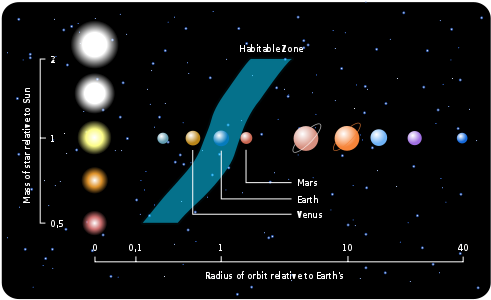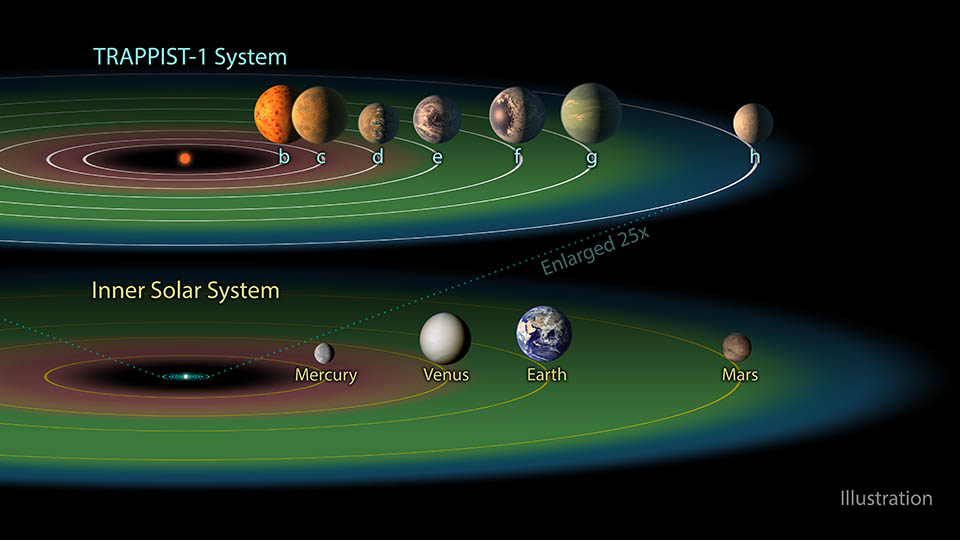Life is precious, yet on Earth it is abundant. As it turns out, our planet is the perfect place for life to exist and thrive. We have water, a major building block of life as we know it, on our planet in its liquid form. From what biologists know about life on Earth, it needs this liquid water to survive. That is why many scientists theorize that the might have been life on Mars at one point since it used to have flowing rivers and that there might even be life on Europa, one of the four Galilean moons of Jupiter. What is so interesting about Earth, is that we fit directly in the middle orbit of our Sun’s Goldilocks zone. A Goldilocks zone is basically the orbital boundaries where water can form in its liquid state, thus making the planet a potential host of life. Mars is also at the far edge of our Sun’s Goldilocks zone because the majority of Mars’ water is frozen in ice caps or underground. Yet theoretically with a stronger atmosphere, Mars could once again harbor liquid water. Below is an image of our solar system demonstrating the goldilocks zone boundaries.

When astronomers look into the stars and search for exoplanets, planets, not in our solar system, they have begun looking for potential planets that might just be able to harbor life. They do this through many methods such as the transit method and by solar radial velocity and from this have detected thousands of exoplanets from advanced telescopes. However, scientists have found that detecting potential life-harboring exoplanets is more difficult than it seems. First off, the majority of exoplanets are gas giants, just because they are easier to detect. These gaseous planets can be many times the size of Jupiter- our biggest planet. Next, the rocky planets detected have to have inside the star’s habitable zone- and have an atmosphere. The orbit can be determined by the planet’s period around the star, and atmosphere can be measured by light diffraction. So detecting these rocky “Super-Earths” that could have water was a fairly rare occurrence.
That was true until NASA developed new technology and sent up better telescopes to look for these specific exoplanets. A few months later, NASA had huge news- they had discovered TRAPPIST-1, a solar system with seven terrestrial planets, with three of them being in their dwarf star’s Goldilocks zone. This is a huge achievement and demonstrates how planetary systems can be common and also demonstrates how there must be life outside of Earth- if we keep finding planets that can house life as we know it, then there must be more life. Although TRAPPIST-1 is a little too far to get to (almost 40 light years) with current technology, it is an important system to study and hopefully travel to once technology gets better.


I think exploring life-harboring exoplanets is a very meaningful task for human-beings. Even though, now what we can find is so far away, seeming untouchable for nowadays technology, it still have extraordinary potentials behind it. We can hold faith on it. Because everything is possible which is the reason why I consider astronomy so charming. It’s really glad to see people achieve those firstly impossible tasks one by one.
It sounds like the new technology and better telescopes NASA is using is a really big breakthrough for finding other habitable planets. I liked that before you talked about the discovery you gave some background information about what planets are able to have liquid water. I had never heard of the Goldilocks zone, but I think it is really interesting.
Hello, Kyle,
Not so far ago, I was also reading about TRAPPIST-1 in the scientific journal, thus this post was not shocking for me. However, information about how NASA is searching for possible habitat planets, was interesting and new, could bring some information about other methods of “searching for a new home for humanity”?
Thank you for your post)
Water indeed, water, water everywhere and the necessary to survive. Scientists now say a number of the TRAPPIST-1 planets comprise extra water than even the oceans of the Earth up to 250 times more. The Number of total Trappist 1 Solar systems are 7. The planets have been named TRAPPIST-1b, 1c, 1d, 1e, 1f, 1g, and 1h. TRAPPIST-1d, the third planet out, and TRAPPIST-1e, the fourth. Those two says Grimm, “are the most likely to have liquid water on them.” You can check out more about update on Trappist -1 Solar system at http://everydayscience.blog/trappist-1-solar-system/